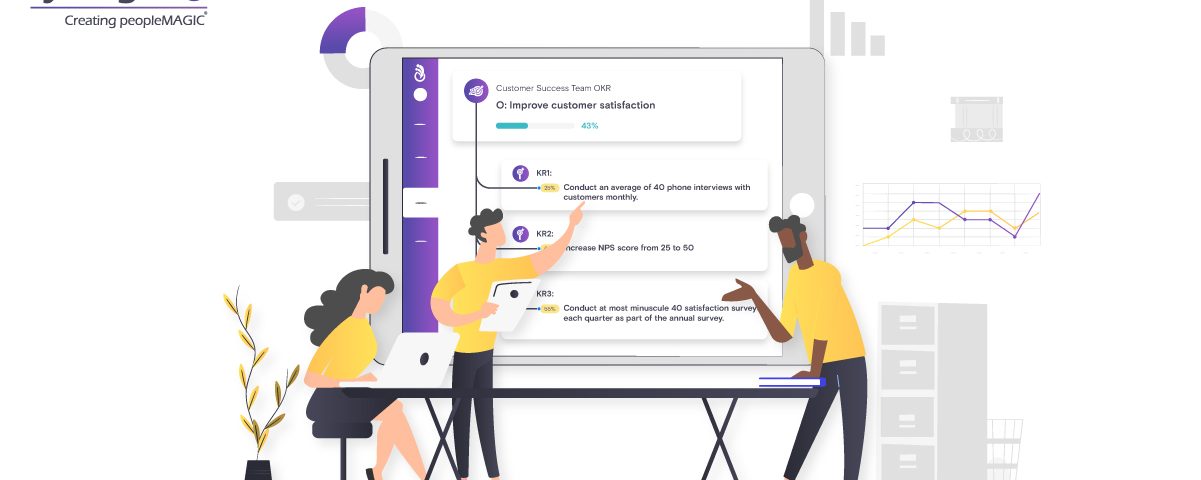Customer success has become synonymous with doing business. After all, it is all about ensuring the customer is happy, delighted, and getting good value from your products and services, right? Furthermore, you could also continuously add more value. For instance, you could share information about other products or services that may meet their future experiential demands. Or you could check to see if their current experiences are on par with their expectations.
It’s why customer success teams play such an important role in the growth of any organization.
However, as the customer’s wants and needs change, so do the demands of the customer success team. The customer success team’s primary responsibility — adapting to the customer — is also its greatest challenge.
To deal with this issue, OKRs bring a proactive, goal-centred focus to the customer success team, helping them adapt to ever-changing customer demands.
Why should your customer success teams use OKRs?
OKR (Objectives and Key Results) is an agile goal-setting framework that promotes transparency and alignment. OKRs are used by multinational corporations such as LinkedIn, Netflix, and Spotify, as well as large corporations such as Samsung and Daimler, to focus on the things that matter the most and align all employees around the company objectives.
Customer success teams frequently face the challenge of having too many tasks at any time. OKRs help focuses on the most critical initiatives and paves plans to achieve them.
Additionally, as business needs are constantly changing, with an agile OKR framework, Customer success teams can seamlessly respond to changes from one OKR cycle to the next.
How can OKRs help customer success teams?
Customer success has typically relied on lagging indicators such as retention, churn, NPS, expansion, and growth to assess the organisation’s health and the effect of its efforts. While these indicators are important long-term KPIs, they do not address the customer success team’s proactive challenges.
OKRs help customer success teams prioritise activities based on leading indicators. For example, if churn rate is a red flag indicator, OKRs can assist customer success teams in establishing objectives around optimising the growth and retention cycles. Customer success teams can develop proactive strategies by tracking key result progress in tandem with essential KPIs.
How to write good Customer success OKRs?
Developing effective Customer success OKRs can take time and effort. While the OKR methodology is easy to grasp, writing objectives and key results is the most challenging and crucial thing to master.
You can consider the following formula while crafting your customer success OKRs to get your creative juices flowing:
We will achieve [Objective] through [Key Results].
Think of it this way; a well-executed OKR plan helps customer success teams anticipate their customers’ wants and requirements rather than just responding to their shifting demands.

Five customer success OKR examples
The first step in creating customer success OKRs is to segment customer success into several verticals, such as retention, loyalty, customer satisfaction, support and more. Following that, you should choose a vertical and establish a long-term goal. And then, make a list of the actions that will help you achieve your goal.
Here, Objectives and Key Results must be time-bound and are usually established quarterly, i.e., for one “OKR cycle.”
1. Objective: Increase customer retention
Key Result 1:Reach a 5% improvement in customer retention over the previous quarter.
Key Result 2: Create a customised renewal pitch for at least 10% of customers.
2. Objective: Increase happiness in customers and reduce churn
Key Result 1: Raise the NPS to 8 this quarter.
Key Result 2: Lower the churn rate to less than 1% this quarter.
3. Objective: Improve customer satisfaction
Key Result 1: Conduct an average of 40 phone interviews with customers monthly.
Key Result 2: Conduct an average of 40 phone interviews with customers monthly.
Key Result 3: Conduct at most minuscule 40 satisfaction surveys each quarter as part of the annual survey.
4. Objective: Provide world-class customer experiences
Key Result 1: All support representatives must have a personal CSAT score of 95% or above.
Key Result 2: Resolve high-priority customer tickets in under 2 hours.
Key Result 3: Resolve mid-priority customer tickets in under 24 hours.
5. Objective: Increase product adoption by 25%
Key Result 1: Ensure that all active and assigned accounts have at least five live touches.
Key Result 2: Create re-engagement messages for each of the 12 customer lifecycle stages.
Key Result 3: Improve the NPS to at least 70 by the end of the quarter.

How can your company optimise its customer success OKRs?
For every company, several important customer-oriented indicators (KPIs) will underpin corporate success. Your customer success OKRs are where you can zero in on the ones that require the most attention in any given quarter. Once you understand the most important KPIs, you can organise efforts that will result in the improvements you seek.
Using a purpose-built OKR tool such as Synergita can take your customer success team’s OKR strategy to the next level. Here are a few benefits:
- Boosts transparency and alignment through goal visualisation
- Enhances collaboration – provide comments on OKRs, appreciate your employees in one place, etc.
- More effortless to use than a spreadsheet or legacy applications
With Synergita’s OKR software, your teams can instantly measure, share, and collaborate on what is needed to boost performance. Sign up for our free trial and test it out yourself.
Related Blogs:
